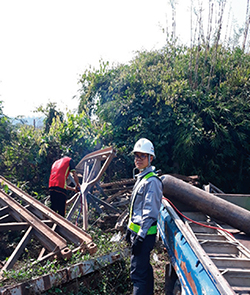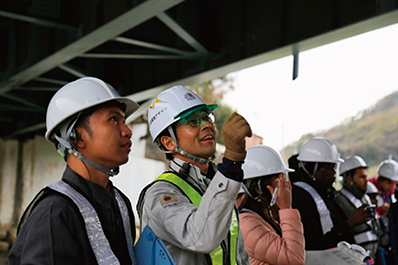Stories from the Field 1Public nomination
Utilizing Japan’s experience in extending the lifetime of the infrastructure in Laos and promoting quality infrastructure!
—Nagasaki University promotes maintenance and management of the road infrastructure in Laos as well as human resources development in this field through industry-government-academia collaboration—

Dr. Thavone confirming the strength of the components of a collapsed Bailey bridge, as part of his research activities in Laos (Photo: Nagasaki University)

An on-site exploratory survey at a bridge during the “Bridge Maintenance” training course (second from the left: Dr. Nishikawa) (Photo: International Development Center of Japan)
Laos is a landlocked country and the movement of people and goods heavily depends on its road network. Laos is as large as Japan’s main island Honshu and about 80% of its territory is in a mountainous area. Therefore, the country needs to operate the road network soundly through the appropriate maintenance and management of over 3,600 bridges scattered across the country in order for the well-balanced socio-economic development of the country. In Laos, more than 15% of the bridges on the national roads have been in service for over 40 years, and 10% of them require early and urgent repairs. The technology for systematically maintaining and managing these bridges had been required in Laos.
In Japan, many bridges were intensively constructed during and after the period of high economic growth and these bridges are aging at the same time as those in Laos. Around half of the bridges in Japan are expected to exceed 50 years of service within a few years. In order to improve the situation, industrial, governmental and academic sectors are working together and research institutes and the industrial sector are leading the development of technological innovations for extending the lifetime of the infrastructure, while central and local governments are promoting the practical application of these technologies.
In line with these trends, Nagasaki University established the “Infrastructures Lifetime-Extending Maintenance Research Center” in 2007, and has been managing its “Michimori” (Road Guardian)” training course for local governments, private companies, NPOs and local residents, which aims to develop human resources for maintenance and management of the road infrastructure. The course has engaged more than 900 people qualified for maintenance and management of the road infrastructure. Nagasaki University takes an initiative and expands its activities covering development of international human resources.
As one of these initiatives, Nagasaki University has accepted government officials and engineers from developing countries and enrolled them in “Bridge Maintenance,” a Knowledge Co-Creation Program (KCCP) of JICA that aims to develop human resources responsible for the maintenance and management of infrastructure. 102 participants from 42 countries enrolled between FY2015 and FY2019 are playing active roles in their own countries while utilizing Japanese technology. In addition, Nagasaki University Graduate School has also accepted government officials, engineers, and researchers from developing countries for JICA’s KCCP Long Term Training, “Core Human Resource Development for Road Asset Management.” Two bridge engineers from the Ministry of Public Works and Transport (MPWT) of Laos were enrolled in the university’s doctoral course through said program and completed it in 2021 with a doctorate degree.
Dr. Thavone, one of the participants, has carried out research on “Load Bearing Behaviors and Maintenance Methodology of Bailey Bridge.”*1He has returned to the MPWT of Laos and has achieved some results for on-site technical guidance on bridge maintenance and management as well as in nurturing junior staffs. He has also been contributing as a key person to the “Project for Capacity Development on Bridge Maintenance and Management,” a technical cooperation project conducted through a public-private-academia collaboration involving Nagasaki University, the International Development Center of Japan, and other stakeholders.
Nagasaki University has been contributing to infrastructure longevity in Laos through practical and academic approach, by dispatching experts to Laos, supporting systematic maintenance and management of 860 bridges on national roads, and trying to ensure that the outcomes of Dr. Thavone and others’ researches are utilized in actual infrastructure maintenance and management on-site. Dr. NISHIKAWA Takafumi, Associate Professor of Nagasaki University and deputy chief advisor of the project, said as follows: “Bridges and other infrastructure play a key role as social apparatus for a very long period of time, from planning to construction and after completion, serving for decades or more than a century. It will not happen overnight to develop organizations, human resources, and technologies for appropriate development, operation, maintenance and management of infrastructure. I really hope that these initiatives in Laos will contribute to the formation of a safe and secure road network and bring about further development of the country.”
In this way, Japan is working to extend the lifetime of the infrastructure in developing countries through industrial-government-academia collaboration involving governments, universities and private companies. Such efforts contribute to the realization of economic viability considering life cycle costs, an element of the “G20 Principles for Quality Infrastructure Investment.”*2
*1 A temporary bridge used in many developing countries. Originally developed for military purposes, this kind of bridge can be easily set up but is not designed for long-term use. As these are being used as regular bridges in developing countries, bridge collapses happen frequently due to overloaded vehicles being driven across them and other similar situations.
*2 See the glossary “Quality Infrastructure.”
Next Page >>
Main Text | Reference Statistics | Stories from the Field | Master Techniques from Japan to the World | ODA Topics
